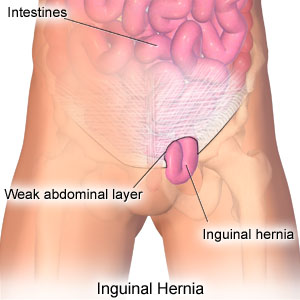
An inguinal hernia occurs when tissue, such as part of the intestine, protrudes through a weak spot in the abdominal muscles. The resulting bulge can be painful, especially when you cough, bend over, or lift a heavy object.
An inguinal hernia is not necessarily dangerous. It does not improve on its own, however, and can lead to life-threatening complications. Your doctor is likely to recommend surgery to fix an inguinal hernia that’s painful or enlarging. Inguinal hernia repair is a common surgical procedure.
In this procedure, which might be done with local anesthesia and sedation or general anesthesia, the surgeon makes an incision in your groin and pushes the protruding tissue back into your abdomen. The surgeon then sews the weakened area, often reinforcing it with a synthetic mesh (hernioplasty). The opening is then closed with surgical glue.
After the surgery, you’ll be encouraged to move about as soon as possible, but it might be several weeks(usually 3-6 weeks) before you’re able to resume normal activities.
Robotic Assisted Inguinal Hernia Repair
In this minimally invasive procedure, which requires general anesthesia, the surgeon operates through three 8mm incisions in your abdomen. Gas is used to inflate your abdomen to make the internal organs easier to see.
A small tube equipped with a tiny camera (laparoscope) is inserted into one incision. Guided by the camera, the surgeon inserts tiny ports through other two incisions. The Robot is then docked to these tiny ports and assist in guiding the instruments under the surgeons control.
People who have Robotic repair have less discomfort and scarring after surgery and a quicker return to normal activities (usually 1-3 weeks).
Robotic surgery allows the surgeon to avoid scar tissue from an earlier hernia repair, so it might be a good choice for people whose hernias recur after traditional hernia surgery. It also might be a good choice for people with hernias on both sides of the body (bilateral).
